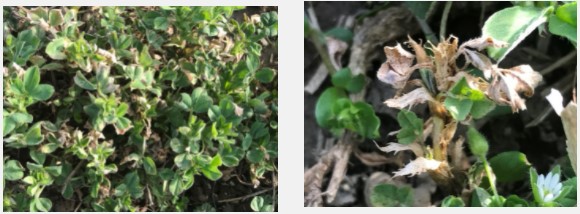By Mark Sulc
The weather forecast this week is indeed concerning for forage stands in general and especially for alfalfa and red clover. The low night temperatures in the forecast may potentially cause severe frost injury to both annual forage crops (e.g. winter rye and winter triticale) and perennials forages.
Growers should scout and evaluate their forage stands several days after the cold nights because predicting freeze damage is difficult to impossible. Freeze damage and plant recovery from it are influenced by many factors, including the absolute minimum low air temperature, soil temperature during the freeze event that can moderate near-surface air temperatures in the canopy, field topography, snow cover during cold nights (that provides insulation), age and stage of plant growth, and stand health and vigor as influenced by soil fertility and prior cutting management.
Figure 1. Alfalfa stem wilting caused by freezing.
The overall vigor of the stand will determine the tolerance to freezing and recovery from freeze injury. Vigorous stands that were not cut in the fall and with good soil pH and fertility will tolerate and recovery from freezing the best.
What to look for in established stands: Damage will initially appear as a wilting of the forage legume leaves and stems, with the top of stems bending over into a “shepherd’s hook” appearance (see Figure 1). This can usually be seen within 24 hours in legumes. This initial wilting might be a little harder to see in perennial grasses. This wilting damage is either temporary if the freeze damage is not too severe, or it is the initial symptom of more severe damage that will appear in the next several days.
Several days after a severe freeze event, leaf and stem death will become obvious, as seen in Figure 2. The shoots and their growing points might be completely killed, but it is rare that the entire crown is killed unless the stand vigor is very poor.

Figure 2. Leaf and stem necrosis from freeze injury in alfalfa.
Several days to a week after the freeze event(s) evaluate established stands to determine the damage.
If a third or less of the tops are damaged, do nothing as the remaining undamaged stems will provide enough growth and yield. There may be some yield reduction, depending on the stand vigor and health. There will likely be some delay in growth resulting in a later first cutting which will help the stand recover more fully.
If most, but not all, of the stem tops are damaged and the stand is less than 10 inches tall, it should recover in time. New existing buds in the axils of leaves in the lower canopy will grow and new crown buds might be initiated and grow as well. Mowing existing top growth will not improve the recovery.
If most of the stem tops are damaged and the stand is more than 12 inches tall, harvest the forage and allow it to regrow.
If all stems are frozen back with severe plant necrosis, the plant is probably dead. If a large portion of the plants in the field exhibit these symptoms, it would be best to plant an emergency forage or interseed the stand with an annual grass forage crop. This scenario is most likely for stands that were abused, older, were not healthy and vigorous, were cut in the fall, or have inadequate soil pH and fertility.
What to look for in new seedings: New seedings made this spring might survive a cold night better than you might think due to the seedlings being close to the warmer soil surface. Seedlings are more freeze tolerant in the cotyledon to first or second trifoliolate leaf stage than at later growth stages. Most new seedings planted in the last few weeks are in these very early stages of development.
If death of the cotyledons and all leaves occurs, the seedlings are probably dead and will not regrow. A good indicator of survival potential is if at least one set of leaves survives the freeze. A companion crop like oat planted with the forage seeding will help protect the newly emerged perennial seedlings.
In summary: Be prepared to assess your forage stand, especially new legume stands, in the days and week following our cold nights that are forecast for later this week. Reach out to your county extension educator with any questions and observations you have about your forage stands. We will be assessing any damage across the state and will follow up with articles in this newsletter in the coming weeks if necessary.